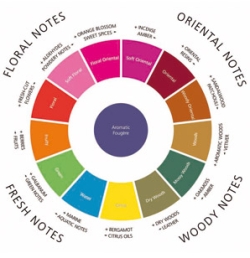 Assigning order to things helps us to avoid chaos. And so it is with fragrance. Like all of us, fragrances can be broken down into their own categories or family trees. Instead of sharing a blood line, however, fragrances may share notes, accords or other characteristics that define their overall similarities.
Assigning order to things helps us to avoid chaos. And so it is with fragrance. Like all of us, fragrances can be broken down into their own categories or family trees. Instead of sharing a blood line, however, fragrances may share notes, accords or other characteristics that define their overall similarities.More often than not, we tend to lean toward a particular fragrance family -- whether we know it or not.
You should keep in mind, however, that each perfume is its own individual entity, made up of its own unique notes. And because of this a perfume can fall into more than one category of fragrance.
That said, there are four main fragrance categories:
Fresh
Floral
Oriental
Woody
Within those four main categories fall 13 families, according to "Fragrances of the World," by scent guru Michael Edwards. And beyond those 13 are numerous combinations of notes that blur the fragrance lines.
Fresh Notes
Edwards' scale of fresh notes is broken down into greens, aquatics and citrus with notes on either side of those blurring into the floral and woody categories that make up his fragrance wheel. (See Michael Edwards' fragrance wheel.)
Green notes are often associated with the crisp scents of the outdoors -- newly cut grass, green flowers, herbs. Water notes invoke the spirit of the sea or the smell of rain. One of the oldest fragrance families, citrus is comprised of the juices of lemons, oranges, bergamot, grapefruit and mandarins.
Floral Notes
The Florals encompass a wide range of blooms, from a single rose petal to a medley of floral bouquets. The floral group is a very popular note group with perfumers as new notes are introduced all the time.
According to Edwards' fragrance wheel, the floral group of fragrances expands to include soft florals, floral orientals, eventually leading into the Oriental group with soft orientals. When you think of soft florals, think light floral scents dusted with powder; they are drier notes, whereas the floral oriental consists of commingling of florals with sweet and spicy notes.
Oriental Notes
Just like its name suggests, the Oriental group is comprised of notes that are sweet, spicy and overall exotic. Notes like amber and vanilla are oftentimes present in the oriental group. Edwards' oriental group includes soft oriental, oriental and woody oriental before officially crossing into the Woody notes group.
Oriental notes are richer and bolder; spices like cardamom and clove make up the oriental notes, as well as chocolate.
Woody Notes
If you didn't already guess, the Woody group consists of your aromatic wood notes -- sandalwood, cedarwood, oak. You will commonly find patchouli mixed in with the woody notes as well.
In a nutshell:
Fresh notes are greens and water scents
Floral notes are your range of flowers
Oriental notes are rich, bold and spicy
Woody scents are your aromatic wood notes
Each group blends with the next to create Edwards' wheel of fragrance.
What about Fougere?
The Aromatic Fougere is at the hub of the fragrance wheel because it takes elements from all the other fragrance families.
You probably have seen fragrances classified as fougere scents, which translated means "fern" in French. Essentially a fougere fragrance is described as one whose base is comprised of lavendar, oakmoss and coumarin, giving it a sharp, woody aroma. There are generally more men's fragrances classified as fougere than women's.


Comments
Write a review